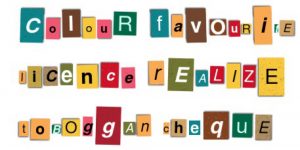
WTF bro, why you different?
By Brittney MacDonald, Life & Style Editor
Autocorrect is often under fire as being a detriment to the Millennial Generation. However, can Canadians really claim this?
It’s no lie that the Canadian vernacular is different from our neighbours to the south. Unfortunately, because of the US’s dominant media exposure, American English is often seen as the English standard and Canadian English is an afterthought—if it is considered at all. However, recognition of the difference doesn’t explain why the divergence exists. For those of you who are curious, allow me to explain.
First and foremost, let’s consider the existence of standardized spelling in general. In 1604 a schoolmaster by the name of Robert Cawdrey consolidated a series of word lists from various educational sources. Cawdrey’s publication is widely regarded as the first English dictionary and therefore stands as the sort of unofficial debut of standardized spelling.
Prior to this, spelling was kind of all over the place and varied depending on context and region. I say context because if you’ve ever been made to look at Middle English literature, then you might have noticed that authors enjoyed using homonyms. An example of this is Geoffrey Chaucer describing one of his characters in the Canterbury Tales as being “hendi,” which is a portmanteau of the Middle English equivalent of “handy” and “handsy.” The character was both useful to have around and also good at finger banging—and you thought medieval literature was chaste! Since there was no standardized spelling, Chaucer was able to get away with this without making his little joke super obvious.
Of course, vocabulary evolved from this point and words changed. However, England still remained the worldly example in terms of use of the English language. What I mean is that in Europe, the form of English used in England is the standard—which makes sense. This means that English translations in places like Germany often source from a similar dialect to Canada, because Canadian English is closer to British/European English than American English.
In North America, however, American pop culture and media are vastly more dominant than Canadian or British media. This is partially because of population density, but also because of distribution, funding, and gatekeeping by media moguls and outlets. Due to this, American English is the version with prime visibility and therefore it has become the standard within North America itself. That’s why there is discourse regarding the two varying English dialects—but why do two exist in the first place?
The reason the two versions exist can be traced all the way back to our political existence. As Canadians, we are a member of the Commonwealth, which technically makes us a territory of the British Empire—something that the US is not. Hence, our vernacular is similar to England’s. However, we also have a very large French influence which affects certain vocabulary choices. Due to acculturation, we have adopted various French and Indigenous linguistic quirks, such as the use of “toboggan” instead of “sled” (which started as a Mi’kmaq word that was appropriated into the Canadian French term “tabaganne,” and finally became “toboggan”). The Francophone heritage also reinforces our use of French derived words such as “parlour” and “centre” maintaining their European spelling. However, we can’t ignore our proximity to the US, so we have also adopted some Americanisms. Fore example, we use “z” instead of “s” in words that end in “ize,” like “realize” and “stylize.”
I guess you could say that Canadian English is kind of like Canada itself. It is a melting pot, but it’s a little guilty of taking on too much American cheese.


